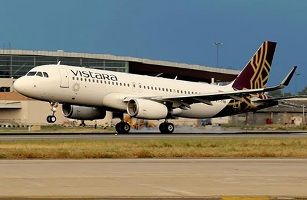Vistara could leverage the opportunity thrown open by the sudden decline of low-cost carrier SpiceJet, which controls over 16 per cent of the domestic market.
 Vistara, the Tata-Singapore Airlines joint venture full-service carrier that received its air operators permit on Monday, is expected to begin operations in India in the second week of January.
Vistara, the Tata-Singapore Airlines joint venture full-service carrier that received its air operators permit on Monday, is expected to begin operations in India in the second week of January.
Given the state of the domestic aviation sector, it appears, the airline could not have found a better time to taste the Indian skies.
To begin with, Vistara could leverage the opportunity thrown open by the sudden decline of low-cost carrier SpiceJet, which controls over 16 per cent of the domestic market.
The Kalanithi Maran-controlled airline has reduced its capacity drastically by cancelling more than 1,800 flights in December.
And there are no signs to suggest it will not do so in January, which might be a worse month for the airline.
According to sources, SpiceJet has severely pruned its fleet and is operating only 17 Boeing aircraft, compared with 37 during its peak.
Though Vistara is not a low-cost carrier, it could benefit from the fact that the difference between the fares of LCCs and economy class of full-service carriers in India is minimal today, thanks to aggressive pricing strategies adopted by FSCs like Air India and Jet Airways to keep customers from moving to LCCs.
The other big benefit might come from the government’s likely move to scrap the 5-20 rule for flying on foreign routes.
Under this rule, domestic carriers must have flown for at least five years within India and possess at least 20 aircraft before they could be permitted to begin foreign operations.
If Vistara gets to fly abroad under an eased regime, Indian consumers will get the much-needed alternative to Air India for international flights.
Apart from concerns over quality of service, Air India has lately been losing its market share to West Asian airlines like Emirates and Etihad.
Vistara, thanks to its Singapore Airlines connection, could leverage its position in many ways -- it could make India an international hub to connect East Asia with Europe through India, or could fly from India to the US on the West Coast via Singapore.
Another benefit for Vistara could come from Jet Airways’ changed strategy.
As part of its plan to align with Etihad in Abu Dhabi, the Naresh Goyal-promoted airline has been reducing its presence in the domestic market and deploying its capacity on international routes.
For instance, in the winter schedule of this year, Jet Airways has reduced its capacity by 8.6 per cent, and subsidiary Jet Lite by 10.8 per cent.
That leave a room open for Vistara to fill in.
However, with only 87 flights to 11 destinations every week -- equivalent to not more than one per cent of the total number of domestic flights annually -- Vistara might seem to be going too slow.
The share of these flights would be two per cent if only FSCs were considered.
Even after four years, assuming other FSCs do not grow, these will account for only seven per cent of the market capacity.
Vistara might surely want to change its plan in due course and become more aggressive, especially when international skies open up.
But if the airline’s route plan is looked at more closely, the strategy seems clear -- go for routes where there is large business-class potential.
For the uninitiated, business-class seats currently account for eight-10 per cent of the total capacity but 15-20 per cent of total domestic aviation revenue.
Business-class fares, typically three to six times higher than economy ones, make for handsome margins for airlines.
Unlike economy or LCC seats, where margins are squeezed because of competition, Vistara could have a business-class configuration of 16-18 seats, according to sources.
If Vistara’s four-year route plan is anything to go by, as much as a third of its flights will be deployed on the lucrative Delhi-Mumbai route, either through direct or indirect flights.
Also, Vistara would deploy half of its flights on routes connecting the four key cities of Delhi, Mumbai, Bengaluru and Hyderabad.
The reason is simple: The country’s top six metros account for about 85 per cent of business-class travellers.
WELL-TIMED
- Vistara could leverage the opportunity thrown open by the sudden decline of low-cost carrier SpiceJet, which controls over 16 per cent of the domestic market
- It could also benefit from the fact that the difference between the fares of LCCs and economy class of full-service carriers in India is minimal today









